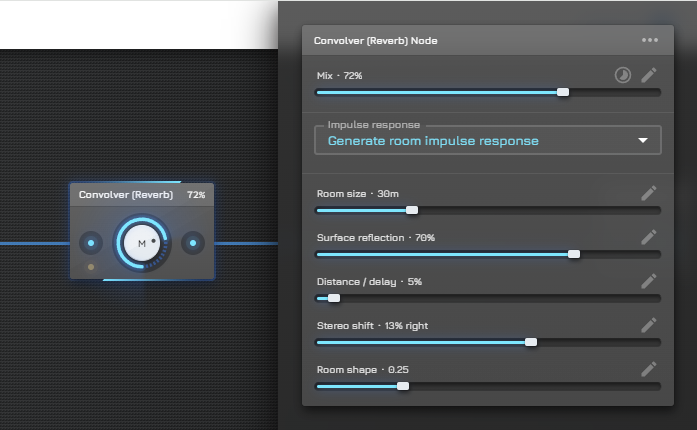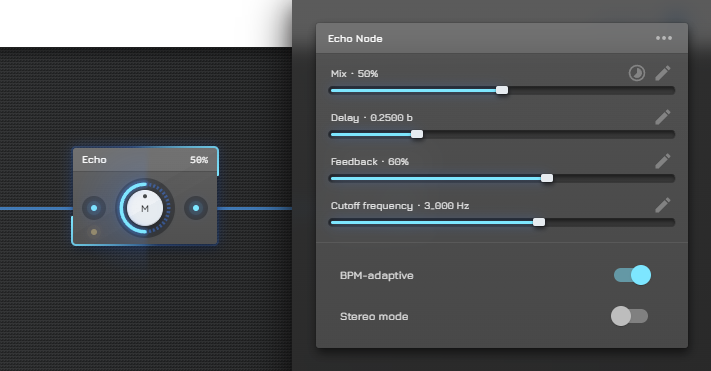Adding a neat reverb effect to an audio file is easy in AudioNodes, and can be done in a minute. AudioNodes has a very advanced way to apply audio effects, and combine or adjust them in real time: effect Nodes.
To start, fire up AudioNodes Online (or download the desktop version for faster performance if you need it), and click or tap to begin if prompted.

Import Your Audio File
On a desktop PC, you can simply drag & drop your audio file into AudioNodes and you are set. Doing so will create an Audio File Node. Alternatively, you can also:
- Right click (or touch and hold) on empty area
- On touch devices: touch and hold on empty area, until the circle completes
- Select Audio Sources
- Select Audio File
- Right click the new Audio File Node, then select Open File (or select Properties, and load your file from the properties panel)
- On touch devices: tap the new Audio File Node, tap the gear icon in the header, then tap the file area to open your file
Add & Connect a Convolver Node
For neat a reverb effect, we’ll need to add a Convolver Node. This adds a reverb using an impulse response, which you can either generate easily, or supply your own from a file if you have it. The idea is that the audio signal will start from the Audio File Node, pass through the Convolver Node, and then finally go to the main audio output:
- Right click (or touch and hold) on empty area, preferably somewhere to the right of your Audio File Node
- Choose “Audio Effects”, then “Convolver”
- Connect your Audio File Node to your new Convolver Node:
- Click/tap on the small blue dot to the right of your Audio File Node
- Click/tap on the small blue dot to the left of your Convolver Node
The reverb is now set up, and it should already be doing its thing nicely by default.

There are plenty of settings to tune however. To access the good stuff:
- Right click the Convolver Node
- Choose Properties
- Note for touch screens: tap on the Convolver Node, then tap on the gear button in the top header menu to access this
- Drag the blue sliders

Output & Play
To listen to the audio from your Audio File Node, it must be ultimately connected to an Audio Destination Node. In this case, through the Convolver Node.
- Right click (or touch and hold) on empty area, preferably somewhere to the right of your Convolver Node
- Choose “Outputs”, then “Audio Destination”
- Connect your Convolver Node to the Audio Destination Node you just created (the same way you connected your Audio File Node to your Convolver Node)
- Hit play from the top bar to listen to the result
- Optionally adjust the Convolver Node while listening to the output – while settings like Room Size and Surface Reflection take a moment to update, the Mix setting can be tuned in real time
Optional: Add an Echo Node into the Mix
The Convolver Node is just one tool to add reverb and environment to your sounds in AudioNodes.
The Echo Node is another option, and it can even be combined with the Convolver Node to create deep, immersive soundscapes very easily. Either place it before or after the Convolver Node. The result will be similar, although not quite the same! Here’s how things look with an Echo Node added into the mix:

Final Step: Render
Once you are satisfied with the results, the final step is to render the results to an output audio file:
- Click/tap the main menu (triple dot button in the top left corner)
- Choose Project
- Choose Export
- Set output settings to your liking, or leave the defaults as-is if they are sufficient
- Hit Start
And that’s it. Depending on the length of your file and quality settings, this process may take a few minutes.
Bonus: More Effects to Add
The way you just added a reverb, AudioNodes has dozens of other effects you can use, such as:
- Changing the volume – Gain Node
- Applying a pitch change – Pitch Shift Node
- Applying a low pass filter – Lowpass Filter Node
Check out all the effect Nodes available in AudioNodes.